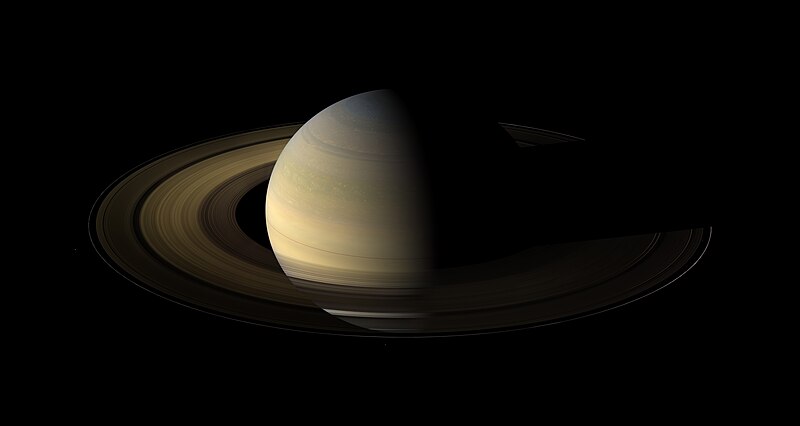File:Saturn, its rings, and a few of its moons.jpg
From Chessprogramming wiki
Jump to: navigation, search

Size of this preview: 800 × 426 pixels. Other resolutions: 320 × 170 pixels | 640 × 341 pixels | 1,024 × 545 pixels | 1,280 × 681 pixels | 7,227 × 3,847 pixels.
Original file (7,227 × 3,847 pixels, file size: 3.58 MB, MIME type: image/jpeg)
This file is from Wikimedia Commons and may be used by other projects. The description on its file description page there is shown below.
Summary
| DescriptionSaturn, its rings, and a few of its moons.jpg |
English: Seen from our planet, the view of Saturn's rings during equinox is extremely foreshortened and limited. But in orbit around Saturn, Cassini has no such problems. From 20 degrees above the ring-plane, Cassini's wide angle camera shot 75 exposures in succession for this mosaic showing Saturn, its rings, and a few of its moons a day and a half after exact Saturn equinox, when the Sun's disk was exactly overhead at the planet's equator. The novel illumination geometry that accompanies equinox lowers the Sun's angle to the ring-plane, significantly darkens the rings, and causes out-of-plane structures to look anomalously bright and to cast shadows across the rings. These scenes are possible only during the few months before and after Saturn's equinox which occurs only once in about 15 Earth years. Also at equinox, the shadows of the planet's expansive rings are compressed into a single, narrow band cast onto the planet as seen in this mosaic. The images comprising the mosaic, taken over about eight hours, were extensively processed before being joined together. First, each was re-projected into the same viewing geometry and then digitally processed to make the image "joints" seamless and to remove lens flares, radially extended bright artefacts resulting from light being scattered within the camera optics. At this time so close to equinox, illumination of the rings by sunlight reflected off the planet vastly dominates any meagre sunlight falling on the rings. Hence, the half of the rings on the left illuminated by planet-shine is, before processing, much brighter than the half of the rings on the right. On the right, it is only the vertically extended parts of the rings that catch any substantial sunlight. With no enhancement, the rings would be essentially invisible in this mosaic. To improve their visibility, the dark (right) half of the rings has been brightened relative to the brighter (left) half by a factor of three, and then the whole ring system has been brightened by a factor of 20 relative to the planet. So the dark half of the rings is 60 times brighter, and the bright half 20 times brighter, than they would have appeared if the entire system, planet included, could have been captured in a single image. The moon Janus (179 kilometres across) is on the lower left of this image. Epimetheus (113 kilometres across) appears near the middle bottom. Pandora (81 kilometres across) orbits outside the rings on the right of the image. The small moon Atlas (30 kilometres across) orbits inside the thin F ring on the right of the image. The brightnesses of all the moons, relative to the planet, have been enhanced between 30 and 60 times to make them more easily visible. Other bright specks are background stars. Spokes -- ghostly radial markings on the B ring -- are visible on the right of the image. This view looks toward the northern side of the rings from about 20 degrees above the ring-plane. |
| Date | |
| Source | NASA CICLOPS |
| Author | NASA/JPL/Space Science Institute |
| Other versions | JPL Photojournal |
The image was taken about 1.25 days after exact equinox. Red, green and blue spectral filters of the wide angle camera and were combined to create this natural colour view. The image was obtained at a distance of approximately 847,000 kilometres from Saturn and at a Sun-Saturn-spacecraft, or phase, angle of 74 degrees. Image scale is 50 kilometres per pixel.
Licensing
| Public domainPublic domainfalsefalse |
| This file is in the public domain in the United States because it was solely created by NASA. NASA copyright policy states that "NASA material is not protected by copyright unless noted". (See Template:PD-USGov, NASA copyright policy page or JPL Image Use Policy.) |  | |
 |
Warnings:
|
Captions
Add a one-line explanation of what this file represents
Items portrayed in this file
depicts
12 August 2009
File history
Click on a date/time to view the file as it appeared at that time.
| Date/Time | Thumbnail | Dimensions | User | Comment | |
|---|---|---|---|---|---|
| current | 18:08, 7 June 2014 |  | 7,227 × 3,847 (3.58 MB) | NH2501 | Lower compression, taken from http://www.dlr.de/media/en/desktopdefault.aspx/tabid-4986/8423_read-12880/8423_page-2 |
File usage
The following page links to this file:
Metadata
This file contains additional information, probably added from the digital camera or scanner used to create or digitize it.
If the file has been modified from its original state, some details may not fully reflect the modified file.
| Image title |
|
|---|---|
| Width | 7,227 px |
| Height | 3,847 px |
| Bits per component |
|
| Compression scheme | Uncompressed |
| Pixel composition | RGB |
| Orientation | Normal |
| Number of components | 3 |
| Horizontal resolution | 72 dpi |
| Vertical resolution | 72 dpi |
| Data arrangement | chunky format |
| Software used | Adobe Photoshop CS2 Windows |
| File change date and time | 13:05, 13 January 2010 |
| Color space | Uncalibrated |
| Image width | 7,227 px |
| Image height | 3,847 px |
| Date and time of digitizing | 14:05, 13 January 2010 |
| Date metadata was last modified | 14:05, 13 January 2010 |
| IIM version | 2 |